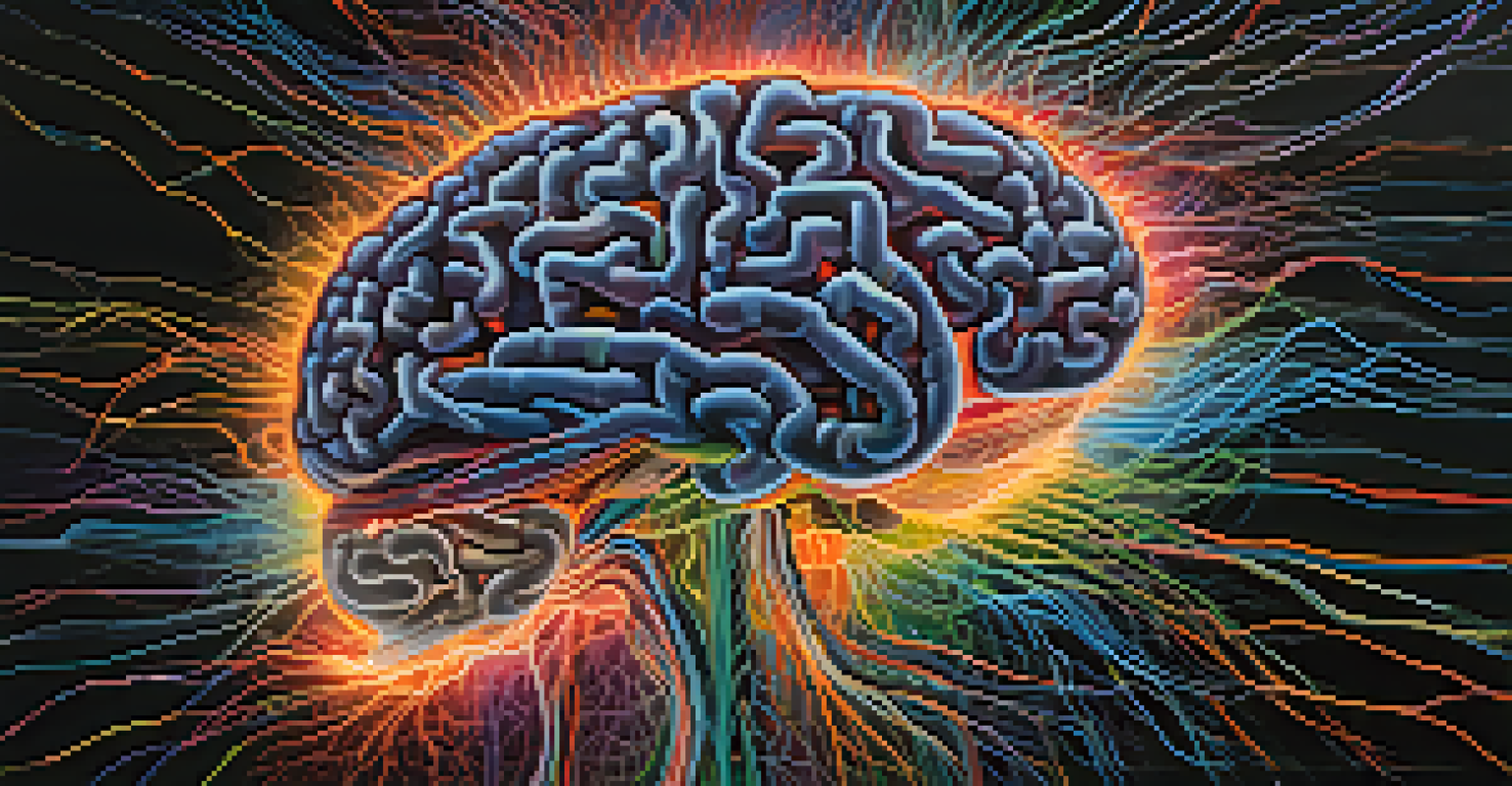Hallucinogens and the Hypothalamic-Pituitary Axis Interaction

What Are Hallucinogens and Their Effects?
Hallucinogens are substances that alter perception, mood, and cognitive processes. Common examples include LSD, psilocybin (magic mushrooms), and mescaline. These drugs can induce vivid hallucinations and profound changes in thought processes, leading to unique experiences that vary widely among individuals.
The greatest discovery of my generation is that a human being can alter his life by altering his attitudes.
The effects of hallucinogens often stem from their interaction with serotonin receptors in the brain, particularly the 5-HT2A receptor. This interaction can lead to heightened sensory perception, altered sense of time, and significant emotional shifts. For many users, these experiences can be therapeutic, offering new perspectives on personal struggles.
However, the unpredictability of hallucinogenic experiences means they are not without risks. Some users may encounter 'bad trips,' marked by anxiety or paranoia, underscoring the importance of understanding these substances and their effects on the mind and body.
Understanding the Hypothalamic-Pituitary Axis (HPA)
The hypothalamic-pituitary axis (HPA) is a complex network that plays a crucial role in regulating stress responses and various bodily functions. It involves the hypothalamus, pituitary gland, and adrenal glands, working together to release hormones like cortisol. This system is vital for maintaining homeostasis and responding to stressors.

When the body encounters stress, the HPA axis kicks into gear, signaling the release of hormones that prepare the body for a 'fight or flight' response. This process can affect everything from mood and energy levels to immune function. Given the HPA axis's role in stress regulation, its interaction with hallucinogens is a fascinating area of study.
Hallucinogens Alter Perception
Hallucinogens like LSD and psilocybin significantly change mood, perception, and cognitive processes by interacting with serotonin receptors.
Understanding how hallucinogens influence the HPA axis can shed light on their potential therapeutic benefits. For instance, some studies suggest that these substances might help alleviate symptoms of anxiety and depression by modulating stress responses, although more research is needed to fully grasp this relationship.
The Interaction Between Hallucinogens and the HPA Axis
Research indicates that hallucinogens may affect the HPA axis, leading to alterations in hormone levels and stress response. For instance, studies have shown that substances like psilocybin can influence cortisol release, which is a key hormone involved in the body's stress response. This connection between hallucinogens and the HPA axis is critical for understanding their psychological effects.
The mind is everything. What you think you become.
When hallucinogens are consumed, they can lead to significant shifts in mood and perception, which may also impact how the HPA axis regulates stress. Some users report feeling a profound sense of connectedness and reduced anxiety, suggesting that these substances could help recalibrate the HPA axis. This recalibration may be particularly beneficial for individuals dealing with chronic stress or mental health disorders.
However, the exact mechanisms of this interaction remain an area of ongoing research. Understanding how hallucinogens influence the HPA axis could unlock new therapeutic avenues, but it also raises questions about the potential risks and benefits of using these substances in a clinical setting.
Potential Therapeutic Uses of Hallucinogens
Hallucinogens have garnered attention for their potential therapeutic applications, particularly in treating mental health conditions like depression and PTSD. Preliminary studies suggest that substances such as MDMA and psilocybin can lead to lasting improvements in mood and emotional well-being. Their ability to facilitate deep introspection and emotional processing is thought to be a key factor in these positive outcomes.
The interaction between hallucinogens and the HPA axis may play a significant role in their therapeutic effects. By modulating stress responses and hormone levels, these substances could help patients better cope with trauma and anxiety. This opens up exciting possibilities for incorporating hallucinogens into psychotherapeutic practices.
HPA Axis Influences Stress Responses
The hypothalamic-pituitary axis regulates stress responses, and its interaction with hallucinogens may help alleviate anxiety and depression.
Despite the promising research, it's essential to approach the use of hallucinogens in therapy with caution. A controlled environment and professional guidance are crucial to ensuring safety and efficacy, as the unpredictable nature of hallucinogens can lead to adverse experiences if not managed properly.
Risks and Considerations of Using Hallucinogens
While hallucinogens can offer therapeutic benefits, they also come with inherent risks that must be considered. The potential for 'bad trips,' which can induce feelings of fear and paranoia, is one significant concern. Additionally, individuals with a history of mental health issues may be at higher risk for adverse reactions when using these substances.
The interaction between hallucinogens and the HPA axis is another area of concern. Alterations in hormone levels can have wide-ranging effects, including impacts on mood and cognition. It's essential for individuals to be aware of their mental health history and consult professionals before experimenting with these substances.
Moreover, the legal status of many hallucinogens varies significantly across different regions, which can complicate their use. As research progresses and more is understood about the therapeutic potential and risks of hallucinogens, ongoing dialogue about safety, legality, and ethics will be crucial in shaping their future use.
Current Research Trends in Hallucinogen Studies
Current research on hallucinogens is expanding rapidly, with a focus on their effects on the brain and their potential therapeutic applications. Studies are increasingly exploring how these substances impact the HPA axis and emotional regulation. This area of inquiry is shedding light on how hallucinogens can alter stress responses and contribute to psychological healing.
Researchers are also investigating the long-term effects of hallucinogen use, especially in clinical settings. Understanding how these substances can lead to lasting changes in mood and behavior is essential for harnessing their therapeutic potential. Early findings suggest that even a single session with certain hallucinogens can result in significant, enduring benefits for mental health.
Therapeutic Potential and Risks
While hallucinogens show promise for treating mental health issues, risks such as 'bad trips' and legal considerations necessitate cautious use.
As the stigma surrounding hallucinogens diminishes, more institutions are committing resources to this line of research. This shift could lead to groundbreaking discoveries that not only inform clinical practices but also reshape our understanding of consciousness and mental health.
Conclusion: The Future of Hallucinogens in Medicine
The exploration of hallucinogens and their interaction with the HPA axis is an exciting frontier in medicine and psychology. With a growing body of research supporting their potential therapeutic benefits, these substances could redefine treatment approaches for various mental health disorders. However, it’s vital to approach this field with both enthusiasm and caution.
The key to unlocking the full potential of hallucinogens lies in understanding their mechanisms of action, particularly concerning the HPA axis. As researchers continue to investigate this relationship, we may uncover new ways to leverage these substances in safe, effective therapeutic settings.

Ultimately, the future of hallucinogens in medicine will depend on ongoing research, regulatory developments, and a commitment to prioritizing patient safety. With careful exploration, we may be on the cusp of a new era in mental health treatment that embraces the complexity and depth of the human experience.